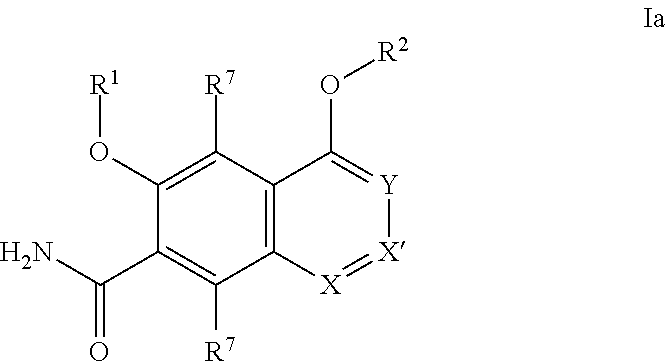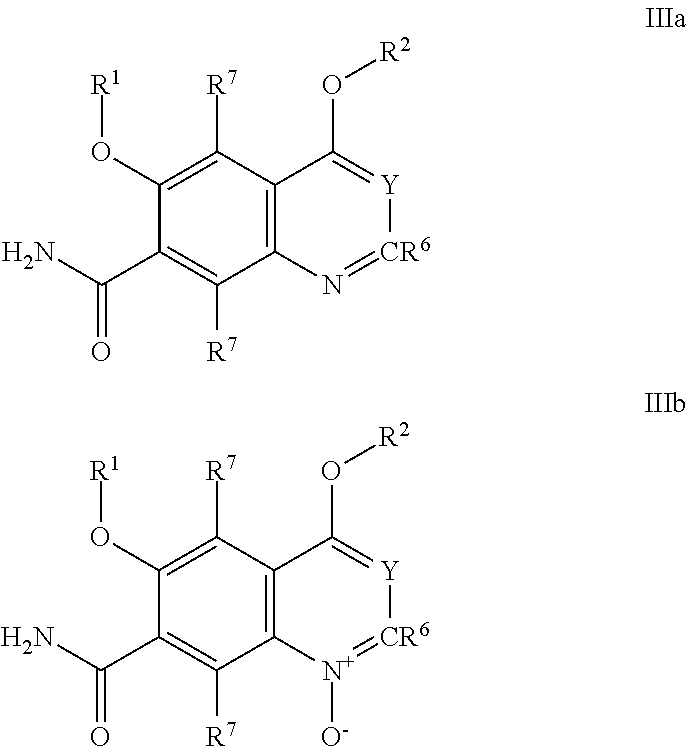Bicyclic-Fused Heteroaryl Or Aryl Compounds
a technology of aryl compounds and bicyclic sulfide, which is applied in the field of bicyclic sulfide heteroaryl or aryl compounds, can solve the narrow irak4-null individual phenotype of immunodeficiency
- Summary
- Abstract
- Description
- Claims
- Application Information
AI Technical Summary
Benefits of technology
Problems solved by technology
Method used
Image
Examples
experimental procedures
and Working Examples
[0348]The following illustrate the synthesis of various compounds of the present invention.
[0349]Additional compounds within the scope of this invention may be prepared using the methods illustrated in these Examples, either alone or in combination with techniques generally known in the art.
[0350]It will be understood that the intermediate compounds of the invention depicted above are not limited to the particular enantiomer shown, but also include all stereoisomers and mixtures thereof. It will also be understood that compounds of Formula Ia can include intermediates of compounds of Formula Ia.
Experimental Procedures
[0351]Experiments were generally carried out under inert atmosphere (nitrogen or argon), particularly in cases where oxygen- or moisture-sensitive reagents or intermediates were employed. Commercial solvents and reagents were generally used without further purification, including anhydrous solvents where appropriate (generally Sure-Seal™ products fro...
example 27
4-[(2-oxopyrrolidin-3-yl)oxy]-6-(propan-2-yloxy)quinoline-7-carboxamide
[0471]
[0472]To 3-hydroxypyrrolidine-2-one (100 μmol) in DMSO (500 μL) was added a 1M solution of tBuOK in THF (100 μL) and the reaction mixture was stirred at 30° C. for 30 min. A 0.1M solution of 4-chloro-6-isopropoxyquinoline-7-carboxamide in THF (Preparation 38, 500 μL, 50 μmol) was added and the reaction mixture was shaken at 30° C. for 16 h. The reaction was quenched by the addition of saturated ammonium chloride solution (50 μL, 100 μmol), filtered and purified using preparative HPLC as described below.
[0473]Purification Method: Phenomenex Gemini C18 250×21.2 mm, 8 μm; organic mobile phase: MeCN; aq mobile phase: ammonium hydroxide pH=10; Gradient time=10 min; flow rate=30 mL / min. Organic gradient was between 18-48%.
[0474]LCMS Method: XBRIDGE 50×2.1 mm, 5 μm; mobile phase A: 0.05% NH4OH in water; mobile phase B: 100% MeCN; gradient from 5% B to 100% B at 3.40 mins, hold at 100% B to 4.20 mins and finally re...
example 28
4-{[(3R)-1-(cyanoacetyl)piperidin-3-yl]oxy}-6-(propan-2-yloxy)quinoline-7-carboxamide
[0475]
[0476]To (R)-4-(piperidin-3-yloxy)-6-(propan-2-yloxy)quinoline-7-carboxamide (Example 58, 500 mg, 1.37 mmol) in DCM was added 2-cyanoacetic acid (140 mg, 1.64 mmol), BOP (733 mg, 1.64 mmol) and TEA (0.57 mL, 4.10 mmol). The reaction mixture was stirred at room 0 temperature for 2 h before washing with water. The organic layer was dried over Na2SO4, filtered and concentrated in vacuo. The residue was triturated with DCM and diethyl ether to afford a yellow solid that was further purified by silica gel column chromatography eluting with 0-10% MeOH in DCM. The residue was triturated with DCM and diethyl ether to afford the title compound as a white solid (271 mg, 50%). 1H NMR (400 MHz, DMSO-d6): δ 8.62-8.60 (m, 1H), 8.22-8.20 (m, 1H), 7.70-7.50 (m, 2H), 7.50-7.40 (m, 1H), 7.20-7.00 (m, 1H), 5.00-4.80 (m, 2H), 4.30-3.60 (m, 5H), 3.40-3.10 (m, 3H), 2.10-1.70 (m, 2H), 1.60-1.40 (m, 6H).
[0477]LCMS Me...
PUM
| Property | Measurement | Unit |
|---|---|---|
| temperature | aaaaa | aaaaa |
| temperatures | aaaaa | aaaaa |
| temperature | aaaaa | aaaaa |
Abstract
Description
Claims
Application Information
 Login to View More
Login to View More - R&D
- Intellectual Property
- Life Sciences
- Materials
- Tech Scout
- Unparalleled Data Quality
- Higher Quality Content
- 60% Fewer Hallucinations
Browse by: Latest US Patents, China's latest patents, Technical Efficacy Thesaurus, Application Domain, Technology Topic, Popular Technical Reports.
© 2025 PatSnap. All rights reserved.Legal|Privacy policy|Modern Slavery Act Transparency Statement|Sitemap|About US| Contact US: help@patsnap.com



